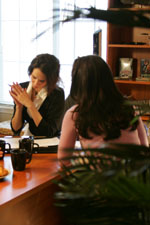An Expert's Look at Taking Reservations
Reservations are the starting point for the entire dining experience, and hiring and training staff who are equipped to be great at taking reservations is a critical component of any successful restaurant. If this is true, how is it that so many restaurant managers consider taking reservations to be an afterthought, even going so far as to let any staffer handle the phone?
Anyone handling reservations should be friendly, informative, and grateful toward the guest. They should be standing near the reservations list and be trained to answer as many questions the guest might have as possible. They should not sound busy or harried, even when they are facing a lobby full of people.
In many restaurants, managers begin with this intent, and they genuinely wish to fill their hostess stand with smart, enthusiastic people. But too often this effort peters out, and answering the phone gets lost in the shuffle of handling all the responsibilities that exist immediately in the four walls of the restaurant. In some cases, even managers sound burdened with the task of taking reservations.
This is a mood-killer from the guest’s perspective. It leads to more canceled reservations than most managers would imagine. For this reason alone, managers must make it a high priority to handle reservations with the most professional and friendly manner, setting the stage for a great evening once the guests arrive.
Use a Template
It might seem like common knowledge, but step 1 in taking reservations is to use a template or some other format that applies a ceiling in terms of availability throughout the length of each shift. Managers are constantly converting to easy-to-use software applications such as Open Table, which allow guests to access reservations online. These applications simplify the process, prompting the reservation taker with the right questions and providing answers in a simple, easy-to-find format.
Even without an application like Open Table, the reservation process should be simple. There are four basic pieces of information to each reservation:
- Last name
- Time
- Number of guests
- Special instructions
While a template prompts a hostess when taking reservations, a notepad can do the same. This makes the process automatic and puts the emphasis on the warmth and hospitality of the reservation taker.
Maximize Space
Maximizing space really refers to maximizing time, which requires an understanding of how long guests are likely to stay, which tables are preferable, and how to be creative about table use. Specifically, reservation takers must:
- Use time windows: Know the average length of time for table turns, and use this as a guide for how long a table is going to be seated.
- Use up attractive tables first: The opening guests of a shift will prefer to use booths or tables in a corner or away from traffic. Begin by filling this space and work from there.
- Use extra tables: Special occasions and large parties often require having extra tables in storage that can be used in a pinch.
- Be resourceful about table space: Tables can often be pulled together to make larger tables. In many cases, accommodating guests really means finding a way to be resourceful and creative to maximize space.
There will be many instances in which a guest calls to make a reservation, and it is unclear if the reservation can be taken. The reservation taker must do what he can to find room in the restaurant, and this often means carefully tracking time windows and rearranging tables to squeeze the most space out of the dining room.
Never Say No
This is rule number one in the restaurant business. Even when the dining room is booked for the evening, the answer shouldn’t be no. Instead, the reservation taker must find suitable alternatives, either at a different time, in the bar/lounge, or even for a different evening. In some cases – especially holidays – a waiting list can be used as an alternative.
It may be tempting to tell a guest that they cannot be helped, and that even might be the more candid response. However, the reservation taker should always provide a reasonable solution so that as few guests as possible are turned away.
